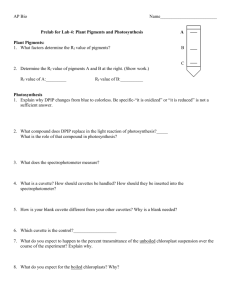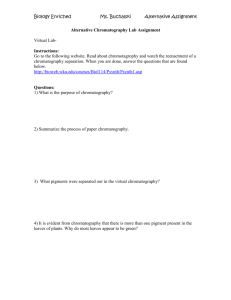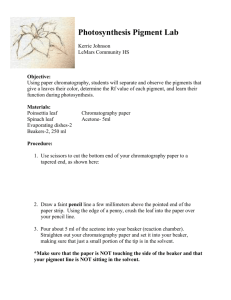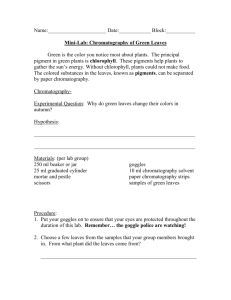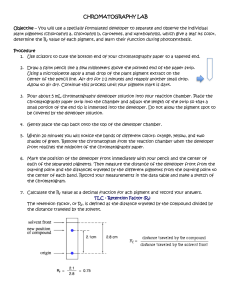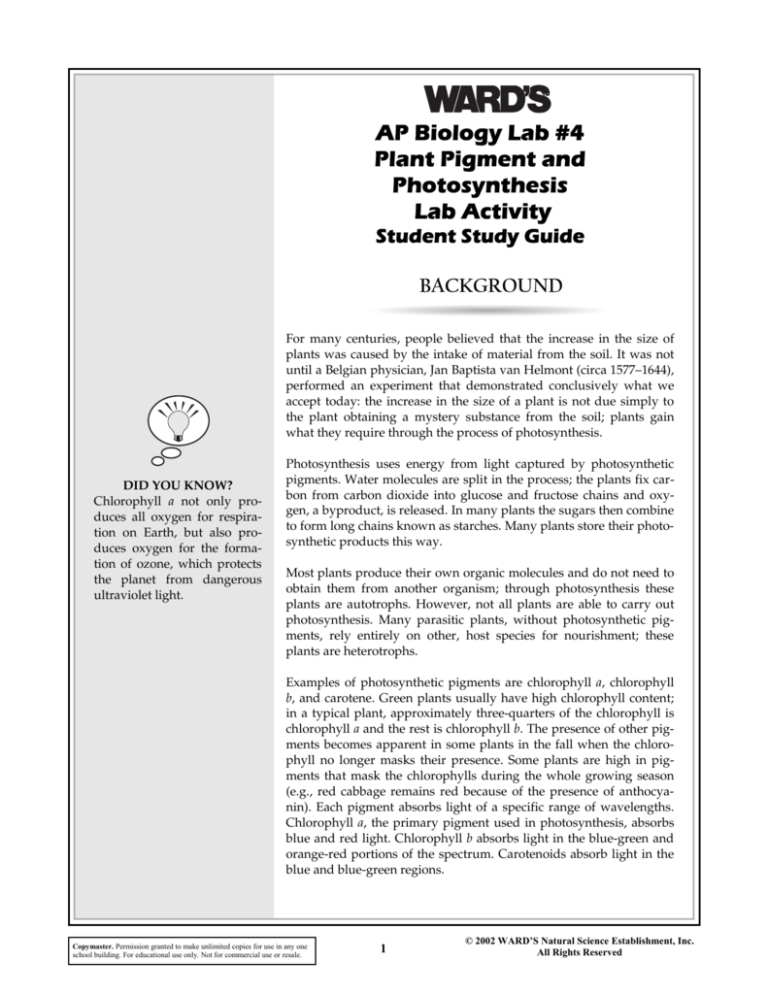
TM
AP Biology Lab #4
Plant Pigment and
Photosynthesis
Lab Activity
Student Study Guide
BACKGROUND
For many centuries, people believed that the increase in the size of
plants was caused by the intake of material from the soil. It was not
until a Belgian physician, Jan Baptista van Helmont (circa 1577–1644),
performed an experiment that demonstrated conclusively what we
accept today: the increase in the size of a plant is not due simply to
the plant obtaining a mystery substance from the soil; plants gain
what they require through the process of photosynthesis.
DID YOU KNOW?
Chlorophyll a not only produces all oxygen for respiration on Earth, but also produces oxygen for the formation of ozone, which protects
the planet from dangerous
ultraviolet light.
Photosynthesis uses energy from light captured by photosynthetic
pigments. Water molecules are split in the process; the plants fix carbon from carbon dioxide into glucose and fructose chains and oxygen, a byproduct, is released. In many plants the sugars then combine
to form long chains known as starches. Many plants store their photosynthetic products this way.
Most plants produce their own organic molecules and do not need to
obtain them from another organism; through photosynthesis these
plants are autotrophs. However, not all plants are able to carry out
photosynthesis. Many parasitic plants, without photosynthetic pigments, rely entirely on other, host species for nourishment; these
plants are heterotrophs.
Examples of photosynthetic pigments are chlorophyll a, chlorophyll
b, and carotene. Green plants usually have high chlorophyll content;
in a typical plant, approximately three-quarters of the chlorophyll is
chlorophyll a and the rest is chlorophyll b. The presence of other pigments becomes apparent in some plants in the fall when the chlorophyll no longer masks their presence. Some plants are high in pigments that mask the chlorophylls during the whole growing season
(e.g., red cabbage remains red because of the presence of anthocyanin). Each pigment absorbs light of a specific range of wavelengths.
Chlorophyll a, the primary pigment used in photosynthesis, absorbs
blue and red light. Chlorophyll b absorbs light in the blue-green and
orange-red portions of the spectrum. Carotenoids absorb light in the
blue and blue-green regions.
Copymaster. Permission granted to make unlimited copies for use in any one
school building. For educational use only. Not for commercial use or resale.
1
© 2002 WARD’S Natural Science Establishment, Inc.
All Rights Reserved
Plants lose water in two ways: from inside the leaves through transpiration, and from the surface of the leaves or from the soil through
evaporation. The total loss of water from both sources is called
evapotranspiration. To reduce the water lost through transpiration,
leaves can close their pores, or stomata, using special cells called
guard cells. However, this also limits the exchange of air and other
gases, which enter and exit the leaves through the stomata, so photosynthesis might also be limited.
DID YOU KNOW?
The word chromatography
comes from the Greek:
chromatos, meaning color and
graphe, meaning writing.
DID YOU KNOW?
Pliny the Elder (23-79AD)
first reported the separation
of dyes on papyrus.
Plants may adapt to this by capturing sunlight’s energy during the
day, storing the energy until night, and exchanging gases at that time
when water loss is lower due to the lower temperatures. This is
known as the “light phase” of photosynthesis. The “dark phase” of
photosynthesis can occur during the light or the dark, while the light
phase can occur only when wavelengths of light that will stimulate
photosynthetic pigments are present.
The first step in the conversion of light to chemical energy is the absorption of light by a pigment system. In all photosynthetic cells, except photosynthetic bacteria, the pigment system includes chlorophyll a. Chlorophyll a occurs in all photosynthetic eukaryotes and in
prokaryotic blue-green algae. In vascular plants, bryophytes, green
algae, and euglenoid algae, chlorophyll b, an accessory pigment, is
also found. In the leaves of green plants, chlorophyll b generally constitutes about one-fourth the total chlorophyll content. Chlorophyll b
absorbs light wavelengths different from chlorophyll a, extending the
range of light that can be used for photosynthesis. It shares with chlorophyll a the ability to absorb light energy and produce an excited
state in the molecule. The excited molecule of chlorophyll b transfers
its energy to a molecule of chlorophyll a, which then transforms it
into chemical energy. Chlorophyll c or chlorophyll d takes the place
of chlorophyll b in other groups of plants.
Carotenoids are also accessory pigments involved in the capture of
light energy in photosynthesis. Carotenoids are red, orange, or yellow
fat-soluble pigments found in all chloroplasts and also, in association
with chlorophyll a, in the prokaryotic blue-green algae. There are two
classes of carotenoids: those that do not contain oxygen are called
carotenes, and those that do contain oxygen are called xanthophylls.
In green leaves, the color of the carotenoids is masked by the much
more abundant chlorophylls; in some tissues, such as those of a ripe
tomato or the petals of an orange flower, the carotenoids predominate. During autumn, chlorophyll begins to break down as the leaf
begins to senesce, allowing the carotenes and xanthophylls to display
the brilliant colors we associate with fall.
Carotenoids, which are not water soluble, are not found free in the
cytoplasm, but like the chlorophylls are bound to proteins within the
plastids. Only certain carotenoids serve as accessory pigments, but
these are important for the overall process of photosynthesis in the
green plant.
Copymaster. Permission granted to make unlimited copies for use in any one
school building. For educational use only. Not for commercial use or resale.
2
© 2002 WARD’S Natural Science Establishment, Inc.
All Rights Reserved
To measure the percentage of each wavelength of light absorbed by a
pigment (the absorption spectrum), a spectrophotometer is used. A
spectrophotometer directs a beam of light of a specific wavelength at
the object to be analyzed, and records what percentage of the light of
each wavelength is absorbed by the pigment or pigment system. The
absorption spectrum is different from the action spectrum, which
graphs the efficiency of different wavelengths of light in promoting a
given photoresponse, as in photosynthesis or phototropism.
A spectrophotometer can also be employed to measure the rate of
photosynthesis. In the dye-reduction technique, the compound DPIP
(2,6-dichlorophenol-indophenol) is substituted for NADP
(nicotinamide adenine dinucleotide phosphate), the primary electronaccepting compound of photosynthesis. As DPIP is reduced by
chloroplasts in the presence of light, it changes from blue to colorless.
The spectrophotometer measures the increase in light transmittance
over time, and thus indicates the rate of photosynthesis.
Chromatography is a technique for analyzing or separating mixtures
of gases, liquids, or dissolved substances such as chlorophyll pigments. There are many types of chromatography, including column,
paper, thin-layer, gas–liquid, ion exchange, and gel filtration. In general, all types of chromatography involve two distinct phases: the stationary phase and the mobile phase. The separation depends on competition for molecules of sample between the mobile phase and the
stationary phase.
DID YOU KNOW?
Forensic scientists use certain
chromatography techniques
to analyze drugs and the dyes
in cloth fibers.
Column, paper, and thin-layer chromatography can be used to separate extracted plant and algal pigments. In paper chromatography,
the separation takes place through absorption and capillary action. A
drop of the mixture to be separated is placed at the bottom of a strip
of chromatography paper, which holds the substance by absorption.
The chromatography paper and developer are then placed in a chamber. The paper acts as a wick, drawing the developer upward by capillary action and dissolving the mixture as it passes over it. The components of the spotted mixture move upward at differing rates, determined by both the solubility of the pigments in the solvent and their
relative attractions to the cellulose of the chromatography paper, resulting in the different pigments in the mixture showing up as colored streaks or bands. The pattern formed on the paper is called a
chromatogram.
To establish the relative rate of migration for each pigment, the Rƒ
value of each pigment is calculated. The Rƒ value represents the ratio
of the distance a pigment moved on the chromatogram relative to the
distance the solvent front moved. It is calculated using the following
formula:
Rƒ = Distance Substances Traveled
Distance Solvent Traveled
Any molecule in a given solvent matrix has a uniquely consistent Rƒ .
The Rƒ value is used by scientists to identify molecules.
Copymaster. Permission granted to make unlimited copies for use in any one
school building. For educational use only. Not for commercial use or resale.
3
© 2002 WARD’S Natural Science Establishment, Inc.
All Rights Reserved
OBJECTIVES
•
•
•
Separate plant pigments using chromatography
Calculate Rƒ values for four different plant pigments
Measure the rate of photosynthesis using a spectrophotometer
MATERIALS
MATERIALS NEEDED PER GROUP
1
1
4
15
DID YOU KNOW?
A typical plant cell may contain as many as fifty
chloroplasts.
Vial
Chromatography paper strip
Cuvettes
Pipets
Chromatography solvent, 10 ml
Quarter
Spinach
Indophenol solution, 3 ml
Phosphate buffer, 4 ml
Prepared boiled chloroplast
Prepared unboiled chloroplast
Parafilm
Test tube rack
Spectrophotometer
Floodlight, 100 W
Aluminum foil
PROCEDURE
PART A: CHROMATOGRAPHY OF PLANT
PIGMENTS
Protective gloves, goggles, and an apron should be
worn throughout this activity.
FUME HAZARD
When working with the chromatography solvent, use a
chemical hood or proper ventilation. Refer to the enclosed MSDS for disposal instructions for the solvent.
1. Obtain a chromatography vial from your teacher and label it with
your initials using a permanent marker or wax pencil.
Copymaster. Permission granted to make unlimited copies for use in any one
school building. For educational use only. Not for commercial use or resale.
4
© 2002 WARD’S Natural Science Establishment, Inc.
All Rights Reserved
Figure 1
!
Step 2 should be performed under a chemical fume hood
or with proper ventilation.
CAUTION
2. Go to a fume hood or a well ventilated area and remove the cap
from a chromatography vial. Using a disposable pipet, add 1 ml
of chromatography solvent to the vial. Replace the cap and allow
the chamber to sit undisturbed until needed in Step 7. This will
ensure that the atmosphere within the vial is saturated with solvent vapors (equilibration).
3. Obtain a chromatography strip from your instructor. Be sure to
handle the chromatography strip by the edges. Do not touch the
surface of the strip. The oils from your fingers can interfere with
the chromatogram.
Figure 2
4. Measure 1.5 cm from one end of the chromatography strip and
draw a pencil line across the width of the strip.
5. Use a pair of scissors to cut two small pieces below the pencil line
to form a pointed end (Figure 1). The pointed end will be referred
to as the bottom end of the chromatogram.
6. Obtain a fresh piece of spinach and place it over the line on the
chromatography strip. Rub the ribbed edge of a coin (dime or
quarter) over the spinach leaf to extract the pigments. Repeat 5 to
10 times with different portions of the spinach leaf, making sure
you are rubbing the coin over the pencil line (Figure 2).
!
Steps 7-11 should be performed under a chemical fume
hood or with proper ventilation.
CAUTION
Figure 3
7. Remove the cap from your chamber and carefully place the chromatography strip into the vial so that the pointed end is barely
immersed in the solvent. Make sure not to immerse the pigments
in the solvent (Figure 3).
8. Cap the vial and leave it undisturbed. Observe as the solvent is
drawn up the chromatography strip by capillary action. You will
be able to see the plant pigments separating along the strip. Notice the different colors that you see during this process.
9. When the solvent reaches approximately 1 cm from the top of the
strip, remove the cap from the vial. Using forceps, remove the
strip from the vial. This is a chromatogram.
Copymaster. Permission granted to make unlimited copies for use in any one
school building. For educational use only. Not for commercial use or resale.
5
© 2002 WARD’S Natural Science Establishment, Inc.
All Rights Reserved
10. Immediately mark the location of the solvent front. The solvent
will evaporate quickly.
Figure 4
11. In Table 2 in the Analysis section, list the pigment colors that you
observe. Once the strip has dried, mark the middle of each pigment band on your chromatography strip with a pencil.
12. Using a metric ruler, measure the distance from the original pencil
line with the spinach extract to the solvent front and each mark
you have made for each pigment band (Figure 4). Record these
distances in millimeters in Table 1 in the Analysis section.
13. Calculate the Rf value for each pigment on your chromatogram
using the following formula and record your answers in Table 1.
Rf = Distance pigment traveled
Distance solvent traveled
14. Follow your teacher’s instructions for proper disposal of all
materials.
Refer to the MSDS for proper disposal of
chromatography solvent.
WASTE
DISPOSAL
Part B: Photosynthesis / The Light Reaction
1.
Turn on the spectrophotometer to warm it up. Refer to the instruction manual for your spectrophotometer to determine how
long it will take to warm up. Adjust the wavelength control knob
to 605 nm.
2.
Set up an incubation area with a floodlight, a flask of water for a
heat sink, and a test tube rack or similar sample holder (Figure 5).
Figure 5
Copymaster. Permission granted to make unlimited copies for use in any one
school building. For educational use only. Not for commercial use or resale.
6
© 2002 WARD’S Natural Science Establishment, Inc.
All Rights Reserved
3.
With a glass-marking pen, label four cuvettes at the very top rim
1, 2, 3, and 4. Wipe down the outside of each cuvette with lens
paper to remove any fingerprints and oils.
4.
Wrap the outside of cuvette 2 with foil and make a foil cap for the
top to keep the chloroplast solution in complete darkness. It will
be used as the experiment control.
5.
Add the following:
Cuvette
1
2
3
4
Phosphate Buffer
1 ml
1 ml
1 ml
1 ml
Distilled Water
4 ml
3 ml
3 ml
3 ml
—
1 ml
1 ml
1 ml
DPIP
DID YOU KNOW?
Many scientists believe that
chloroplasts and mitochondria have evolved from
prokaryotic “trespassers” that
invaded other, larger cells, a
speculation known as the
endosymbiotic theory.
6.
Zero the spectrophotometer by adjusting the amplifier control
knob until the meter reads 0% transmittance.
7.
Obtain 2 ml of boiled chloroplast and 2 ml of unboiled chloroplast. Transfer three drops of unboiled chloroplasts to cuvette 1.
Cover the top of the cuvette with parafilm and invert to mix.
8.
Place cuvette 1 in the sample holder of the spectrophotometer. Be
sure the cuvette is wiped clean and is inserted into the sample
holder in the same direction every time to ensure consistent readings. Adjust the light control knob until the meter reads 100%
transmittance.
NOTE
9.
Cuvette 1 will be used to recalibrate the spectrophotometer
between readings.
Transfer three drops of unboiled chloroplasts into cuvette 2 with
a pipette. Immediately cover the cuvette with parafilm and invert
to mix.
10. Remove the foil sleeve and foil top, and place the cuvette in the
sample holder. Read the percent transmittance and record it as
Time 0 in Table 2 in the Analysis section of the lab.
11. Place the cuvette back into its foil sleeve and cover it with the foil
top. Place the cuvette in the test tube rack between percent transmittance readings.
12. Repeat the readings at 5, 10, and 15 minutes. Be sure to cover and
mix the cuvette before each reading. Read the percent transmittance and record the data in Table 2.
Copymaster. Permission granted to make unlimited copies for use in any one
school building. For educational use only. Not for commercial use or resale.
7
© 2002 WARD’S Natural Science Establishment, Inc.
All Rights Reserved
NOTE
Be sure to use cuvette 1 to check and recalibrate the spectrophotometer between each reading to ensure consistent
results.
13. Transfer three drops of the unboiled chloroplasts into cuvette 3.
Immediately cover the cuvette with parafilm and invert to mix.
14. Place the cuvette in the sample holder. Read the percent transmittance and record it as Time 0 in Table 2.
15. Place the cuvette in the test tube rack between percent transmittance readings.
16. Repeat the readings at 5, 10, and 15 minutes. Be sure to cover and
mix the cuvette before each reading. Read the percent transmittance and record the data in Table 2.
NOTE
DID YOU KNOW?
The car toon character
“Popeye” attributes his amazing strength to a daily diet of
spinach. In fact, spinach is an
excellent source of both vitamin A and folic acid, as well
as iron and potassium.
Be sure to use cuvette 1 to check and recalibrate the spectrophotometer between each reading to ensure consistent
results.
17. Transfer three drops of the boiled chloroplasts into cuvette 4. Immediately cover the cuvette with parafilm and invert to mix.
18. Place the cuvette in the sample holder. Read the percent transmittance and record it as Time 0 in Table 2.
19. Place the cuvette in the test tube rack between percent transmittance readings.
20. Repeat the readings at 5, 10, and 15 minutes. Be sure to cover and
mix the cuvette before each reading. Read the percent transmittance and record the data in Table 2.
NOTE
Copymaster. Permission granted to make unlimited copies for use in any one
school building. For educational use only. Not for commercial use or resale.
Be sure to use cuvette 1 to check and recalibrate the spectrophotometer between each reading to ensure consistent
results.
8
© 2002 WARD’S Natural Science Establishment, Inc.
All Rights Reserved
WARD’S
AP Biology Lab #4
Plant Pigments and Photosynthesis
Lab Activity
Name:
Group:
Date:
ANALYSIS
Table 1
Chromatography of Plant Pigments
Band Number
Pigment
Migration Distance
(mm)
Rf Value
1 (top)
2
3
4
—
Table 2
% Transmittance
Time
Cuvette
0 min.
5 min.
10 min.
15 min.
2 (Dark)
3 (Unboiled)
4 (Boiled)
Copymaster. Permission granted to make unlimited copies for use in any one
school building. For educational use only. Not for commercial use or resale.
9
© 2002 WARD’S Natural Science Establishment, Inc.
All Rights Reserved
WARD’S
AP Biology Lab #4
Plant Pigments and Photosynthesis
Lab Activity
Name:
Group:
Date:
ASSESSMENT
1.
Which pigment migrated the farthest? Why?
2.
During summer, leaves are generally bright green. What would you hypothesize that this indicates
about the role of green light wavelengths, chlorophyll, and the photosynthetic process?
3.
Design an experiment to test your hypothesis from the question above. Describe your experiment or
draw a picture of your experimental setup. If you draw your setup, be sure to label each component
and its purpose.
4.
Why do leaves change color in autumn?
5.
What is the function of the chlorophylls in photosynthesis?
Copymaster. Permission granted to make unlimited copies for use in any one
school building. For educational use only. Not for commercial use or resale.
10
© 2002 WARD’S Natural Science Establishment, Inc.
All Rights Reserved
6.
What are the accessory pigments and what are their functions?
7.
In your experiment you used paper chromatography to separate various pigment molecules. There
are several other chromatographic techniques employed to separate a variety of molecules. Research
another form of chromatography and describe it below.
8.
What does the Rƒ value represent? If you were to perform your experiment on a chromatography
strip that was twice the length of the one you used, would your Rƒ values still be the same?
9.
Shown below is a strip of chromatography paper and a list of five molecules and their various Rƒ
values. Assuming the solvent front traveled 54 mm, place each molecule where it would be found
on the finished chromatogram.
Solvent front
Copymaster. Permission granted to make unlimited copies for use in any one
school building. For educational use only. Not for commercial use or resale.
11
Molecule
Rƒ value
N,N-fictionol
.41
cis-2,4-pretendium
.20
dl-made-upelene
.72
d(+)-tetra-imaginase
.91
polysynthetic acid
.78
© 2002 WARD’S Natural Science Establishment, Inc.
All Rights Reserved
10. What is the absorption spectrum?
11. In what way is the spectrophotometer used to measure the rate of photosynthesis?
12. Below is graphic representing the steps in the process of photosynthesis. Place the components from
the list into their proper place on the graphic.
H2O
O2
CO2
ATP
Light
NADPH
Sugar
Calvin Cycle
Light Reactions
Copymaster. Permission granted to make unlimited copies for use in any one
school building. For educational use only. Not for commercial use or resale.
12
© 2002 WARD’S Natural Science Establishment, Inc.
All Rights Reserved

